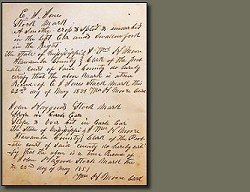
For years, the southeastern quarter of
Itawamba County has been known as the “Jug District,” where, during the nineteenth century well into the early twentieth century, pottery shops were operated. All types of wares were produced by these shops. The wares were produced from native clays dug from the
Itawamba County hillsides. Most of the wares were utilitarian objects such as churns, crocks and pots but one item produced by the Loyd pottery operations just south of Tremont on
James Creek, had perhaps a lasting impact on current genealogical studies in
Itawamba County. That unique pottery item was the clay cemetery monument.
The following newspaper article was transcribed from the May 17, 1888 edition of the Fulton Reporter: “James Creek is the only portion of our county where manufacturing of any kind is carried on extensively. There the hills are dotted everywhere with jug factories. And the amount of wares turned out annually and the money brought into the county by its sale is truly astonishing. The famous clay tombstones are also made there. These were invented in 1879 by Rev. William Boyd (editor’s note: should be Loyd), and we believe it is the only invention ever patented in Itawamba. They are however, a credit to genius, and answer their purpose fully as well as those of marble and granite, at a great deal less cost. They beautifully combine in their structure the qualities of neatness and durability, and have sold readily ever since they were first placed on the market. We wish more of our gifted sons would try their hands at the art of invention. They could not serve their country in a better capacity, and by that means could soon place us beyond an agricultural dependency.”
Because of the low cost of these monuments, many families in northeast Mississippi and northwest Alabama were afforded the opportunity to mark the graves of their loved ones long since gone decades earlier, and because of this unique invention producing a low-cost product, many graves of our ancestors would otherwise be unmarked today.
 For detailed information about these unique cemetery monuments and the people who made them, as well as the cast iron monuments seen in many old Itawamba cemeteries, read the summer 2007 issue of Itawamba Settlers magazine, where an article about the unique cemetery monuments of Itawamba County is featured. An excellent article about these unique pottery monuments is also found on Terry Thornton’s Hill Country of Monroe County blog.
For detailed information about these unique cemetery monuments and the people who made them, as well as the cast iron monuments seen in many old Itawamba cemeteries, read the summer 2007 issue of Itawamba Settlers magazine, where an article about the unique cemetery monuments of Itawamba County is featured. An excellent article about these unique pottery monuments is also found on Terry Thornton’s Hill Country of Monroe County blog.
 For years, the southeastern quarter of
For years, the southeastern quarter of  For detailed information about these unique cemetery monuments and the people who made them, as well as the cast iron monuments seen in many old Itawamba cemeteries, read the summer 2007 issue of Itawamba Settlers magazine, where an article about the unique cemetery monuments of
For detailed information about these unique cemetery monuments and the people who made them, as well as the cast iron monuments seen in many old Itawamba cemeteries, read the summer 2007 issue of Itawamba Settlers magazine, where an article about the unique cemetery monuments of 




No comments:
Post a Comment